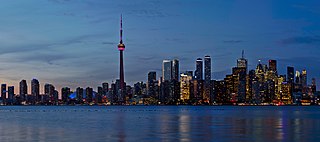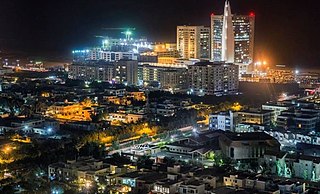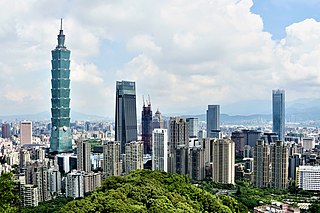Related Research Articles

The economy of Canada is a highly developed mixed economy, with the world's tenth-largest economy as of 2023, and a nominal GDP of approximately US$2.117 trillion. Canada is one of the world's largest trading nations, with a highly globalized economy. In 2021, Canadian trade in goods and services reached $2.016 trillion. Canada's exports totalled over $637 billion, while its imported goods were worth over $631 billion, of which approximately $391 billion originated from the United States. In 2018, Canada had a trade deficit in goods of $22 billion and a trade deficit in services of $25 billion. The Toronto Stock Exchange is the tenth-largest stock exchange in the world by market capitalization, listing over 1,500 companies with a combined market capitalization of over US$3 trillion.

The economy of Germany is a highly developed social market economy. It has the largest national economy in Europe, the third-largest by nominal GDP in the world, and fifth by GDP (PPP). Due to a volatile currency exchange rate, Germany's GDP as measured in dollars fluctuates sharply. In 2017, the country accounted for 28% of the euro area economy according to the International Monetary Fund (IMF). Germany is a founding member of the European Union and the Eurozone.

The economy of Kazakhstan is the largest in Central Asia in both absolute and per capita terms. In 2021, Kazakhstan attracted more than US$370 billion of foreign investments since becoming an independent republic after the collapse of the former Soviet Union.

The economy of Pakistan is classified as a developing economy. It is the 24th-largest in terms of GDP based on purchasing power parity (PPP) and 46th largest in terms of nominal GDP. As of 2023, the country has a population of 232 million people. According to the International Monetary Fund (IMF), on a per capita income basis, Pakistan ranked 161st by GDP (nominal) and 138th by GDP (PPP).

The economy of South Korea is a highly developed mixed economy. By nominal GDP, ₩2.24 quadrillion, it has the 4th largest economy in Asia and the 12th largest in the world. South Korea is notable for its rapid economic development from an underdeveloped nation to a developed, high-income country in a few generations. This economic growth has been described as the Miracle on the Han River, which has allowed it to join the OECD and the G20. South Korea remains one of the fastest-growing developed countries in the world following the Great Recession and the COVID-19 recession. It is included in the group of Next Eleven countries as having the potential to play a dominant role in the global economy by the middle of the 21st century.

The economy of Taiwan is a highly developed free-market economy. It is the 8th largest in Asia and 20th-largest in the world by purchasing power parity, allowing Taiwan to be included in the advanced economies group by the International Monetary Fund. Taiwan is notable for its rapid economic development from an agriculture-based society to an industrialised, high-income country. This economic growth has been described as the Taiwan Miracle. It is gauged in the high-income economies group by the World Bank. Taiwan is one of the most technologically advanced computer microchip and high-tech electronics industries makers in the world.

The Rust Belt, formerly the "Steel Belt", is a region of the Northeastern and Midwestern United States. It includes Central New York, Pennsylvania, Ohio, West Virginia, Indiana, Illinois, the Lower Peninsula of Michigan, southeastern Wisconsin, parts of Kentucky, Baltimore, and the St. Louis metropolitan area in Missouri. Cities in the Rust Belt include Allentown, Buffalo, Chicago, Cincinnati, Cleveland, Detroit, Gary, Philadelphia, Pittsburgh, Rochester, Toledo, Trenton, and Youngstown.

India was one of the richest countries in the world, for about two and a half millennia starting around the end of 1st millennium BC and ending around the beginning of British rule in India.
Japanese foreign policy toward Southeast Asia, the diverse region stretching from South Asia to the islands in the South Pacific Ocean, was in part defined by Japan's rapid rise in the 1980s as the dominant economic power in Asia. The decline in East-West and Sino-Soviet tensions during the 1980s suggested that economic rather than military power would determine regional leadership. During the decade, Japan displaced the United States as the largest provider of new business investment and economic aid in the region, although the United States market remained a major source of Asia-Pacific dynamism.
In its economic relations, Japan is both a major trading nation and one of the largest international investors in the world. In many respects, international trade is the lifeblood of Japan's economy. Imports and exports totaling the equivalent of nearly US$1.309.2 Trillion in 2017, which meant that Japan was the world's fourth largest trading nation after China, the United States and Germany. Trade was once the primary form of Japan's international economic relationships, but in the 1980s its rapidly rising foreign investments added a new and increasingly important dimension, broadening the horizons of Japanese businesses and giving Japan new world prominence.

The trade policy of Japan related to Japan's approach to import and export with other countries.

The economic history of Brazil covers various economic events and traces the changes in the Brazilian economy over the course of the history of Brazil. Portugal, which first colonized the area in the 16th century, enforced a colonial pact with Brazil, an imperial mercantile policy, which drove development for the subsequent three centuries. Independence was achieved in 1822. Slavery was fully abolished in 1888. Important structural transformations began in the 1930s, when important steps were taken to change Brazil into a modern, industrialized economy.

Deindustrialization is a process of social and economic change caused by the removal or reduction of industrial capacity or activity in a country or region, especially of heavy industry or manufacturing industry.

Shrinking cities or urban depopulation are dense cities that have experienced a notable population loss. Emigration is a common reason for city shrinkage. Since the infrastructure of such cities was built to support a larger population, its maintenance can become a serious concern. A related phenomenon is counterurbanization.
The role and scale of British imperial policy during the British Raj on India's relative decline in global GDP remains a topic of debate among economists, historians, and politicians. Some commentators argue the effect of British rule was negative, and that Britain engaged in a policy of deindustrialisation in India for the benefit of British exporters which left Indians relatively poorer than before British rule. Others argue that Britain's impact on India was either broadly neutral or positive, and that India's declining share of global GDP was due to other factors, such as new mass production technologies or internal ethnic conflict.

Manufacturing in Vietnam after reunification followed a pattern that was initially the reverse of the record in agriculture; it showed recovery from a depressed base in the early postwar years. However, this recovery stopped in the late 1970s as the war in Cambodia and the threat from China caused the government to redirect food, finance, and other resources to the military. This move worsened shortages and intensified old bottlenecks. At the same time, the invasion of Cambodia cost Vietnam urgent foreign economic support. China's attack on Vietnam in 1979 compounded industrial problems by damaging important industrial facilities in the North, particularly a major steel plant and an apatite mine.
The textile industry in India traditionally, after agriculture, is the only industry that has generated huge employment for both skilled and unskilled labour. The textile industry continues to be the second-largest employment generating sector in India. It offers direct employment to over 35 million people in the country. India is the world's second largest exporter of textiles and clothing, and in the fiscal year 2022, the exports stood at US$ 44.4 billion. According to the Ministry of Textiles, the share of textiles in total exports during April–July 2010 was 11.04%. During 2009–2010, the Indian textile industry was pegged at US$55 billion, 64% of which services domestic demand. In 2010, there were 2,500 textile weaving factories and 4,135 textile finishing factories in all of India. According to AT Kearney’s ‘Retail Apparel Index’, India was ranked as the fourth most promising market for apparel retailers in 2009.
Deindustrialisation refers to the process of social and economic change caused by the removal or reduction of industrial activity and employment in a country or region, especially heavy industry or manufacturing industry. Deindustrialisation is common to all mature Western economies, as international trade, social changes, and urbanisation have changed the financial demographics after World War II. Phenomena such as the mechanisation of labour render industrial societies obsolete, and lead to the de-establishment of industrial communities.
A circular economy is an alternative way countries manage their resources, where instead of using products in the traditional linear make, use, dispose method, resources are used for their maximum utility throughout its life cycle and regenerated in a cyclical pattern minimizing waste. They strive to create economic development through environmental and resource protection. The ideas of a circular economy were officially adopted by China in 2002, when the 16th National Congress of the Chinese Communist Party legislated it as a national endeavour, though various sustainability initiatives were implemented in the previous decades starting in 1973. China adopted the circular economy due to the environmental damage and resource depletion that was occurring from going through its industrialization process. China is currently a world leader in the production of resources, where it produces 46% of the worlds aluminum, 50% of steel and 60% of cement, while it has consumed more raw materials than all the countries a part of the Organisation for Economic Co-operation and Development (OECD) combined. In 2014, China created 3.2 billion tonnes of industrial solid waste, where 2 billion tonnes were recovered using recycling, incineration, reusing and composting. By 2025, China is anticipated to produce up to one quarter of the worlds municipal solid waste.
Science and technology in Kazakhstan – government policies to develop science, technology and innovation in Kazakhstan.
References
- ↑ Angus Maddison (2006), "The World Economy", OECD Publishing, ISBN 92-64-02261-9 Page 263
- ↑ "Macron pushes nuclear, hydrogen power in €30 billion plan to reverse industrial decline". France 24. 2021-10-12. Retrieved 2022-11-05.
- ↑ ""To Become A Nation Of Innovation Again": France Unveils Re-Industrialisation Plan". NDTV.com. Retrieved 2022-11-05.
- ↑ Tregenna, Fiona. "Manufacturing Productivity, Deindustrialization, and Reindustrialization". United Nations University. Retrieved February 2, 2012.
- ↑ Shute, Toby (Nov 30, 2010). "How to Get Positioned for America's Reindustrialization". The Motley Fool. Retrieved February 2, 2012.